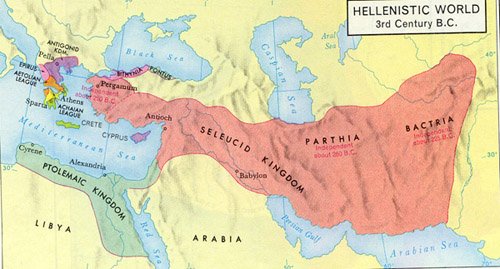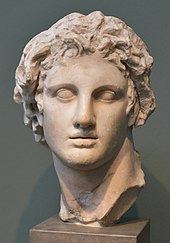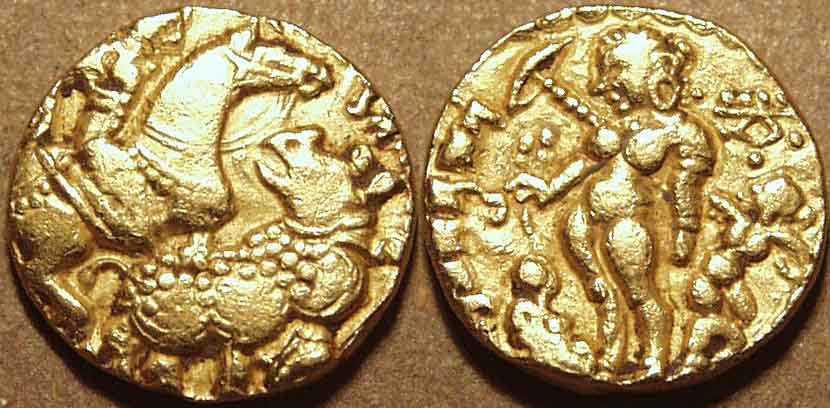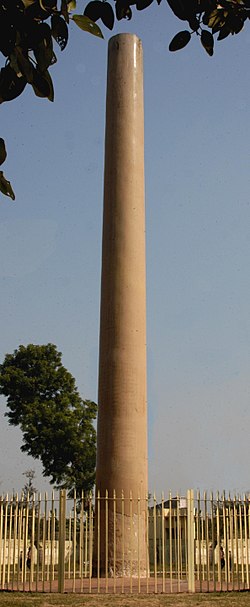
Legend of Vikramaditya
The short thread would try and identify Vikramaditya, mention legends about him and would place him historically, in proper space and time.
The short thread would try and identify Vikramaditya, mention legends about him and would place him historically, in proper space and time.

Name:
'Vikramaditya' is a title and not a name.
Vikramaditya= Valour like the Sun.
And there have been plenty of kings, who have been identified with this title.
Let us describe them one by one.
'Vikramaditya' is a title and not a name.
Vikramaditya= Valour like the Sun.
And there have been plenty of kings, who have been identified with this title.
Let us describe them one by one.
Vikramaditya of Ujjain ( 57 BCE)
The earliest references to Vikramaditya is in 'Britha-katha manjari', however the book is lost and portions of it may be Gupta era interpolations, like in Katha-saritasagara.
The earliest references to Vikramaditya is in 'Britha-katha manjari', however the book is lost and portions of it may be Gupta era interpolations, like in Katha-saritasagara.
The Jain legends, Al-Beruni described this Vikramaditya as defeating the Sakas, and starting a calender 'Vikram Samvat'.
Al-Beruni clearly states that this calender was used in southern & western India.
Al-Beruni clearly states that this calender was used in southern & western India.
Other theories by D. C. Sarkar, Bhandarkar, et al, suggests that the name of era changed to 'Vikram Samvat' in the reign of Chandra Gupta- II ( 375-414 AD).
Rudolf Hoernlé believed that it was Yashodharman, the king of Malwa in 6th Century, who named this era.
Rudolf Hoernlé believed that it was Yashodharman, the king of Malwa in 6th Century, who named this era.
There is no way to identify this Vikramaditya of Ujjain.
His exploits are described in texts and no coin of his or any of his inscriptions have been found.
Or is it true?
His exploits are described in texts and no coin of his or any of his inscriptions have been found.
Or is it true?
In 2013, a private collector brought a coin to Maharaja Vikramaditya Shodhpeeth in Ujjain, who claimed that coin belonged to Vikramaditya, with King's face on obverse & first century BCE symbols on the reverse. 

However, the coin has only symbols and no legends on it, and it is very difficult to ascribe this to Vikramaditya, as his name in Brahmi is not mentioned on the coin.
It seems very unlikely, as stated in some portions of Puranas that this Vikramaditya controlled the whole earth ( major portions of India).
This Vikramaditya may have controlled portions of Malwa only.
This Vikramaditya may have controlled portions of Malwa only.
Chandra Gupta -II ( 375-414 AD)
This king is our best bet of being ' Vikramaditya' as he used this title in his coins and inscriptions, and like the Vikramaditya of Ujjain, he too defeated the Sakas.
This king is our best bet of being ' Vikramaditya' as he used this title in his coins and inscriptions, and like the Vikramaditya of Ujjain, he too defeated the Sakas.

He used several titles, one of them was ' Sakari'= exterminator of Sakas.
It was this king, who extinguished, the line of Sakas, which ruled western India for 300 years, starting 78 AD, thus bringing the foreign rule of Sakas to an end.
His exploits are described further.

It was this king, who extinguished, the line of Sakas, which ruled western India for 300 years, starting 78 AD, thus bringing the foreign rule of Sakas to an end.
His exploits are described further.


As per Iron Pillar at Mehrauli, ' King Chandra', identified with Chandra Gupta- II, ' had running battles over the 7 rivers ( Beas to Kabul), and went up to Balhika' ( Balkh in Afghanistan).
Image of inscription and the word ' Chandra on Iron pillar.

Image of inscription and the word ' Chandra on Iron pillar.


The inscription credits king Chandra with the following achievements:-
1) Conquest of Vanga countries ( vangeshu), i.e Bengal.
2) Conquest of Vahikas ( North West region of India), in a running fight across the seven mouths of Sindhu river.
1) Conquest of Vanga countries ( vangeshu), i.e Bengal.
2) Conquest of Vahikas ( North West region of India), in a running fight across the seven mouths of Sindhu river.
3) Spread of his fame as a conqueror up to Southern seas.
4) Achievement of sole supreme sovereign ( aikadhirajyam) by prowess ( vikrama) of his arms.

4) Achievement of sole supreme sovereign ( aikadhirajyam) by prowess ( vikrama) of his arms.


Literary Evidences: Raghuvamsa
Kalidasa, the greatest poet and playwright of India, describes in Raghuvamsa that the king " exterminated, the hunas, Sakas, and mlecchas".
Kalidasa, the greatest poet and playwright of India, describes in Raghuvamsa that the king " exterminated, the hunas, Sakas, and mlecchas".

The actual control of this ' Vikramaditya' was far greater than Vikramaditya of Ujjain, and his rule extended from the mountains of Afghanistan to southern seas.
Not even Mauryan Empire went up to Balkh!
Not even Mauryan Empire went up to Balkh!
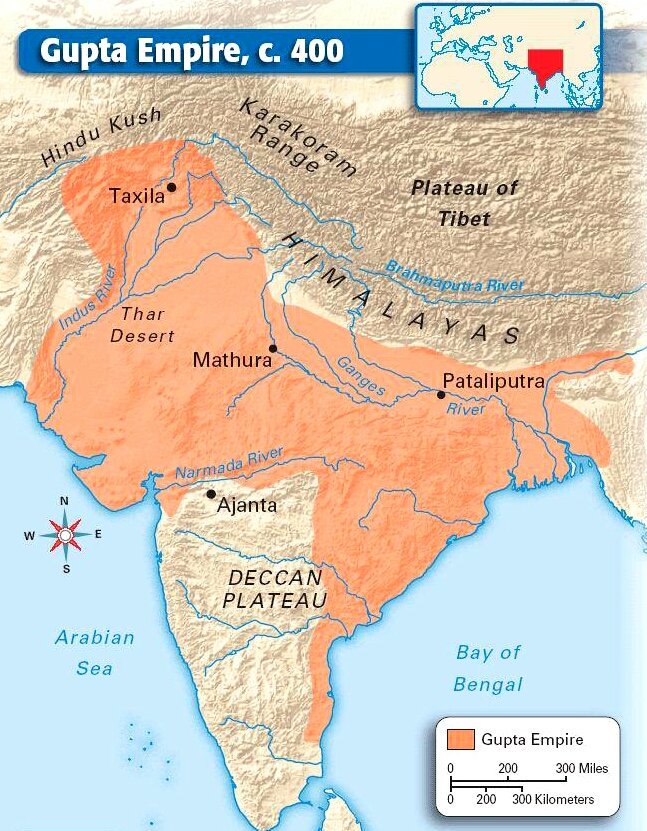
Rock Inscriptions:
The Hunza rock inscriptions ( Gilgit-Baltistan, Pakistan) names the word ' Chandra' in Gupta script, proving the dominance of this king, who has also been called ' Ajitvikrama' = Vikrama, who cannot be defeated.

The Hunza rock inscriptions ( Gilgit-Baltistan, Pakistan) names the word ' Chandra' in Gupta script, proving the dominance of this king, who has also been called ' Ajitvikrama' = Vikrama, who cannot be defeated.


Foreign Description: Administration: Fa- Hien
Fa-Hien, a Chinese pilgrim ( 337-422 AD), has described the condition and administration of India, while on a visit between (399-412 AD), and hence in the rule of Chandra Gupta Vikramaditya.
Fa-Hien, a Chinese pilgrim ( 337-422 AD), has described the condition and administration of India, while on a visit between (399-412 AD), and hence in the rule of Chandra Gupta Vikramaditya.

The following is the description of India as per Fa-Hien, under the rule of Chandra Gupta Vikramaditya:
' The King in his administration uses no corporal punishment; criminals are merely fined according to the gravity of their offences.'
' The King in his administration uses no corporal punishment; criminals are merely fined according to the gravity of their offences.'
' Even for the second attempt at rebellion, the punishment is only the loss of the right hand. The men of King's body- guard have all fixed salaries.'
' Throughout the whole country no one kills any living things, nor drinks wine , nor eats onions or garlic ; but Chandalas are segregated. 'Chandal' is their name for foul men ( lepers).'
' In this country, they do not keep pigs or fowls, there are no dealings in cattle, no butcher's shops or distilleries in their market places.'
This and other observations of Indian society by Fa-Hien, suggests that Indian people have never been governed better than the reign of Chandra Gupta Vikramaditya.
The ' Golden Age of India' started under his father, and reached its peak under him and his successors.
The ' Golden Age of India' started under his father, and reached its peak under him and his successors.
Skanda Gupta Vikramaditya ( 455-467 AD)
He was the grandson of Chandra Gupta Vikramaditya, and is famously known as the 'Saviour of India.'
Apart from using the title of Vikramaditya, he also is called 'Guptavanshakaviraho' = The sole Hero of the Gupta Dynasty.

He was the grandson of Chandra Gupta Vikramaditya, and is famously known as the 'Saviour of India.'
Apart from using the title of Vikramaditya, he also is called 'Guptavanshakaviraho' = The sole Hero of the Gupta Dynasty.


Skanda Gupta is also one of the candidates of being the 'Vikramaditya', which we are searching.
He defeated the Huns, and probably shifted his capital to Ayodhya.
We will see further as to the connection of Ayodhya with Vikramaditya.
He defeated the Huns, and probably shifted his capital to Ayodhya.
We will see further as to the connection of Ayodhya with Vikramaditya.

Vikramaditya II of Chalukyas ( c.730 AD).
The last of the famous 'Vikramadityas', Vikramaditya-II of Badami Chalukyas was a famous and powerful king.
He not only beat the Pallavas, but defeated Arabs, who had designs on conquering India, after their conquest of Sindh.
The last of the famous 'Vikramadityas', Vikramaditya-II of Badami Chalukyas was a famous and powerful king.
He not only beat the Pallavas, but defeated Arabs, who had designs on conquering India, after their conquest of Sindh.
His most memorable moment was the capture of Kanchi on three occasions and his exploits are also inscribed at the Virupaksha temple.
He ruled for 40 years and conducted matrimonial alliances with Rashtrakutas
He ruled for 40 years and conducted matrimonial alliances with Rashtrakutas

Legends about Vikramaditya
1) Betal Pachisi
Vetala Panchavimshati , वेतालपञ्चविंशति, is a collection of tales found in ' Katha-Saritasagara' , written by Somdev in 11th century, and based on still older materials.
1) Betal Pachisi
Vetala Panchavimshati , वेतालपञ्चविंशति, is a collection of tales found in ' Katha-Saritasagara' , written by Somdev in 11th century, and based on still older materials.

The tale talks about 25 stories told by Vetala to King Vikramaditya, ending with a riddle, which he must answer, or he would die.
Richard Burton translated few stories of these tales in 1870's.
Richard Burton translated few stories of these tales in 1870's.

As per the local traditions, near Ujjain and close to Shipra river, the tree from which betal used to hang, existed till about 42 years ago, and the place is now a centre of tantra activities. 

2. Simāsana Dvātriṃśikā or Dvātriṃśat Puttalikā ("Thirty-two Statue Stories")
These are the 32 stories told by nymphs to Raja Bhoj ( 11th century AD), on the bravery and charitable behavior of Vikramaditya.
The author is unknown, and probably written in 11th century AD.
These are the 32 stories told by nymphs to Raja Bhoj ( 11th century AD), on the bravery and charitable behavior of Vikramaditya.
The author is unknown, and probably written in 11th century AD.

3) Ayodhya
According to a legend in Ayodhya, the city was re-discovered by Vikramaditya after it was lost for centuries.
Vikramaditya, afterwards re-populated the city and constructed many temples there.
According to a legend in Ayodhya, the city was re-discovered by Vikramaditya after it was lost for centuries.
Vikramaditya, afterwards re-populated the city and constructed many temples there.

In the 6th century works: the biography of Vasubandhu by Paramartha (499–569) and Vasavadatta by Subandhu., quotes a legend which mentions Ayodhya ("A-yu-ja") as the capital of king Vikramaditya.
'"Pi-ka-la-ma-a-chi-ta" = Vikramaditya
According to this legend, the king gave 300,000 gold coins to the Samkhya scholar Vindhyavasa for defeating Vasubandhu's Buddhist teacher (Buddhamitra) in a philosophical debate.
According to this legend, the king gave 300,000 gold coins to the Samkhya scholar Vindhyavasa for defeating Vasubandhu's Buddhist teacher (Buddhamitra) in a philosophical debate.
4) Another legend of Vikramaditya talks about his confrontation with God Shani, which led him to utter ruin and he gained his kingdom after obliging Shani. 

5) Har ki Paudi:
This famous ghat, as per legends, has been built by Vikramaditya in memory of his brother, Britahari.
The spot is dedicated to Har ( Mahadev) and Vishnu ( Hari), and is one of the most holiest spots in Hinduism.

This famous ghat, as per legends, has been built by Vikramaditya in memory of his brother, Britahari.
The spot is dedicated to Har ( Mahadev) and Vishnu ( Hari), and is one of the most holiest spots in Hinduism.


Conclusion:
One would believe that king did exist, & right from 57 BCE to 11th century, we have evidences in all forms to confirm the existence of Vikramaditya.
Let's dwell a little on all of these ', suspects' on who was the real Vikramaditya, which legends have spoken about
One would believe that king did exist, & right from 57 BCE to 11th century, we have evidences in all forms to confirm the existence of Vikramaditya.
Let's dwell a little on all of these ', suspects' on who was the real Vikramaditya, which legends have spoken about
• • •
Missing some Tweet in this thread? You can try to
force a refresh




